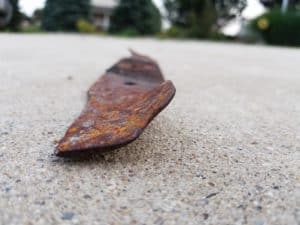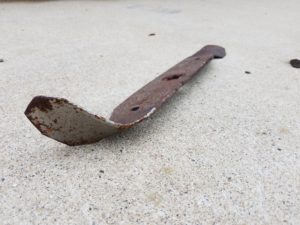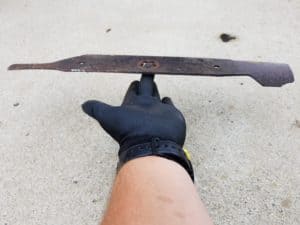I was recently given a riding mower and, like most free equipment people offload, it had a few things that needed some attention. Besides a new battery, oil change and belts, I needed to sharpen up the blades. I made a few mistakes in the process and have learned what not to do. So how do you sharpen a Tractor mower blade? Depending on the tools and equipment you have on hand there are a few techniques that will produce the same outcome. The most important thing is that you understand and master the chisel grind. This is the working edge of your mower blades and is the best edge for this application due to its strength and the inevitability of hitting hard objects. Let’s dive right into the process of sharpening.
How to sharpen mower blades
First you are going to need to remove the blades from your mower deck. Depending on the manufacturer and the model, the way that the blades are attached to the deck may vary. It would be recommended that you reference your owner’s manual.
Once the blades are removed the next step is to choose a method of sharpening. One of the easiest and least expensive ways to sharpen your blades is with a flat file. In order to use a flat file, you are going to have to firmly secure your blade either with a vice or clamped to a workbench. Once the blade is secured in place you can begin to work on your blade by moving the file back and forth on the slanted portion of your blade. Work on the blade until the you have removed all the chips and dents in the cutting edge. You want the angle of the blade to be between 45 and 60 degrees for the best and most consistent cutting.
You will notice that your tractors blades are only sharpened on one side. This type of edge is called a chisel edge or chisel grind and is the superior choice for applications where the blade will be cutting in the same direction at all times. The flat side of the blade runs parallel with the ground so that you get a uniform and clean cut. It is also the easiest to maintain as you only have one edge to sharpen and don’t have to mess with things like grind symmetry. However, the greatest advantage to us busy folk is that it’s really quick to sharpen. Just a minute or so per blade instead of thirty.
Other Sharpening Methods.
Stone
Stones have been used to sharpen blades for centuries. From the time before the Egyptians stones have been used to hone and sharpen dull metal into razor-sharp tools. They are still a very effective option today and a preferred method for many people.
Sharpening stones can be used in much the same way as a file. First, fasten the blade to a hard flat surface. With the blade firmly in place hold the stone down at a 45-degree angle to the blade and make a circular motion with the stone. Many sharpening stones come with two sides, a coarse side for faster material removal and a smoother side to hone the final product to a fine edge. Once you have worked out the minor dents and chips with the coarse side switch to the smoother side to finish off the blade.
This method generally works best for blades that have been maintained and need minor sharpening. It will take a bit longer than some of the other methods however, it will yield a much better-finished product.
Belt Sander
Belt sanders are a power tool (yay for that). So you won’t have to work as hard. This is a wonderful way to remove a lot of material very quickly. If you need to re-shape the edge of the blade or remove large dents and chips this is a fantastic option. Also, it is very easy to be consistent with a tool like this and put a nice looking edge on your blade. Some people make a jig to hold the blade at the exact angle to the belt sander. This cuts down on the time it takes the sharpen and makes the finished result look that much cleaner.
Many hobby knife makers use this tool almost exclusively to create beautiful pieces of art. With a little practice and skill, this tool can do almost anything in the ways of shaping and sharpening metal. Out of all the powered tool options for sharpening this would be my number one choice.
Grinding Wheel
This would be one of my least favorite option to sharpening a mower blade. The difficulties with this method are that you don’t have as much control for doing finer work. Also, it is almost impossible to get a great chisel grind edge because you are dealing with a rounded instead of a flat sharpening surface.
However, if you are not as much of a perfectionist and you just want to get a fresh edge on the mower blade fast and get back to cutting your grass then this is the tool for you. These things remove a lot of metal fast. They throw sparks too so be careful if you stand to close you will put a bunch of tiny holes in your shirt (voice of experience). Finally, these are a pretty common tool. You can find them everywhere. If you don’t have one there is a good chance your neighbor has one and will let you use it for the few minutes it will take to sharpen your blades.
How do you know that your blades need sharpening?
There are a few ways that you can tell when your blades need to be sharpened. One of the easiest ways is to look at the consistency of the fresh cut on your yard. After you mow your yard take a good look. If your yard is patchy with taller grass in some areas then other or with lines and strips of taller grass you are going to want to sharpen your blades.
Another way to see if your blades need some honing is to examine a blade of grass. If the blade of grass is frayed or torn it means your blade is dull. You should see a nice clean cut across the grass if your blades are as sharp as they should be.
Depending on how often you mow your lawn and how big your lawn is you may wont to sharpen your blades more often. As a general rule of thumb, I sharpen my lawn tractor blades at the beginning of every season. For the average person that will be just fine. On the other hand, if you ground out, hit some gravel or hit a rock it never hurts to check the blades.
How many times can you sharpen your blades?
There really are a lot of factors that play into this answer. If you do a good job with the general upkeep of your blades and don’t allow for them to get too dull in between sharpenings then you may have a set of blades that lasts for 10 years and 15 to 20 sharpenings. However, if you hit a lot of brush, debris, dirt, gravel, and stones you are going to need to work out the dents and dings in your blade. That means removing more of the material and shortening the life of your blades. Unfortunately, there are other things that can go wrong with your blades as well that will lower the life of your blades. So when is it best to just change out your blades than to grind and sharpen them?
When should you change your blades
Sometimes it just makes more sense to get yourself a brand new set of blades than to keep grinding away at your current ones and in some cases, it is the safe answer. Mower blades spin at around 3000 Rotations Per Minute and if the quality of the blades has degraded to a certain level it may be dangerous to continue to use the mower deck. In this case, it is best to just change out the blades. So what do you look for in bad or damaged blades?
Cracking and chipping
This is one of the easier things to see right away. Some smaller chips and dents can be ground or filed out of the blade with no problem. However, bigger chips (deeper than a quarter inch) will require you to take out too much material and my cause your blades to be off balance and out of tolerance. The other thing to look for is actual cracks in the blade. These can be extremely dangerous as they can break apart while in rotation and throw razor-sharp shards of metal out from under your deck at 200 miles per hour. If you find even a hairline crack in one of your blades don’t even chance it, replace it immediately.
Thinning

Another easy thing to look for is the thickness of your mower blades. The best place to look for this would be on the back side of the blade the curves or flairs up. If your blades are in good condition this part of the blades will have a nicely visible squared off edge and have about ⅛ to 1/16 of material thickness left. If this is part of the blade is rounded, thin and brittle then its time to change them out.
Warped or bent

Once you remove your blades for sharpening you can easily test them for warping by laying them on a flat surface and inspecting them. If the blades toggle back and forth or don’t lay down all the way flat you have a bad blade on your hands. This will cause uneven cutting as your blades will be cutting at different levels to one another while you mow. This can give a lined effect to your yard.
Unbalanced

This is one thing that is often overlooked. As your blades degrade they can become off balance. If your blade balance becomes uneven it will cause undue stress and wear on other components and gears. As a general rule of thumb, it is easier to replace the blades than any of the other parts that may wear out due to an uneven system. Having blades that are off balance may create more costly problems for you in the future.

